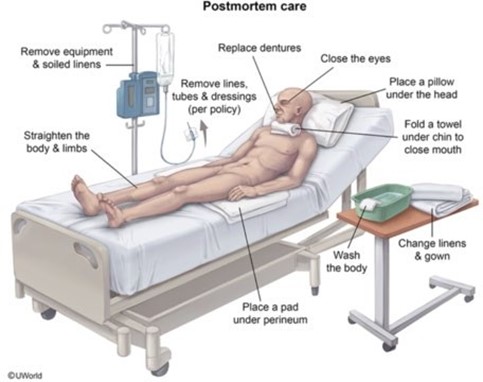A nurse is assigning care to an assistive personnel (AP). Which of the following tasks should the nurse delegate to the AP?
Educating a client on the use of a blood glucose monitor.
Interpreting a client's vital signs.
Performing a central line dressing change for a client.
Providing postmortem care for a client who has died.
The Correct Answer is D
Assistive personnel (AP), also known as unlicensed assistive personnel (UAP), can perform tasks such as assisting with activities of daily living, hygiene, and nutrition, as well as those tasks that support professional nursing assessments ². Providing postmortem care for a client who has died [d] is a task that can be delegated to an AP.
The other options are not tasks that should be delegated to an AP. Educating a client on the use of a blood glucose monitor [a] involves patient education, which is typically the responsibility of a licensed nurse.
Interpreting a client's vital signs [b] involves assessing the client's health status, which is also typically the responsibility of a licensed nurse. Performing a central line dressing change for a client [c] is a complex task that requires specialized knowledge and skills.

Nursing Test Bank
Naxlex Comprehensive Predictor Exams
Related Questions
Correct Answer is C
Explanation
The correct answer is Choice C.
Choice A rationale: Obtaining consent directly from a client who has received IV morphine sulfate is invalid due to impaired cognitive function. Morphine acts on mu-opioid receptors in the central nervous system, reducing alertness, memory retention, and decision-making capacity. Informed consent requires full comprehension of risks, benefits, and alternatives. Morphine’s sedative effects compromise this standard. Normal Glasgow Coma Scale should be 15 for full alertness; sedation lowers this, rendering consent legally and ethically unsound.
Choice B rationale: The nurse cannot legally sign the consent on behalf of the client, even if the client is acknowledged. This violates the principle of autonomy and informed decision-making. The nurse’s role is to witness the client’s signature, not substitute it. Morphine impairs cognition, and any consent obtained under its influence is invalid. Legal standards require that the client be alert, oriented, and capable of understanding the procedure. Proxy consent must be pursued if capacity is compromised.
Choice C rationale: When a client is under the influence of opioids and lacks decision-making capacity, consent must be obtained from a legally authorized representative, such as a relative or healthcare proxy. Morphine alters consciousness and impairs executive function, making the client temporarily incompetent. Legal surrogates are empowered to make healthcare decisions in such cases. This ensures ethical compliance and protects patient rights. The nurse must verify documentation of proxy authority before proceeding with consent.
Choice D rationale: Delaying the procedure may be necessary if no authorized proxy is available, but it is not the first action. The priority is to identify and contact a legally authorized representative to obtain valid consent. Delays can compromise care, especially in urgent surgical cases. The nurse must act promptly to secure proxy consent, ensuring procedural integrity and patient safety. Only if no proxy is reachable should delay be considered, with documentation of rationale.
Correct Answer is B
Explanation
The first action the nurse should take is to speak with the other nurse privately. This allows the nurse to address the mistake in a respectful and professional manner and provide guidance on how to perform the procedure correctly in the future.
Option A is incorrect because correcting the mistake independently does not address the underlying issue of the other nurse performing the procedure incorrectly.
Option C is incorrect because volunteering to perform the procedure next time does not address the underlying issue of the other nurse performing the procedure incorrectly.
Option D is incorrect because submitting an incident report may be necessary, but it should not be the first action taken.
Whether you are a student looking to ace your exams or a practicing nurse seeking to enhance your expertise , our nursing education contents will empower you with the confidence and competence to make a difference in the lives of patients and become a respected leader in the healthcare field.
Visit Naxlex, invest in your future and unlock endless possibilities with our unparalleled nursing education contents today
Report Wrong Answer on the Current Question
Do you disagree with the answer? If yes, what is your expected answer? Explain.
Kindly be descriptive with the issue you are facing.
